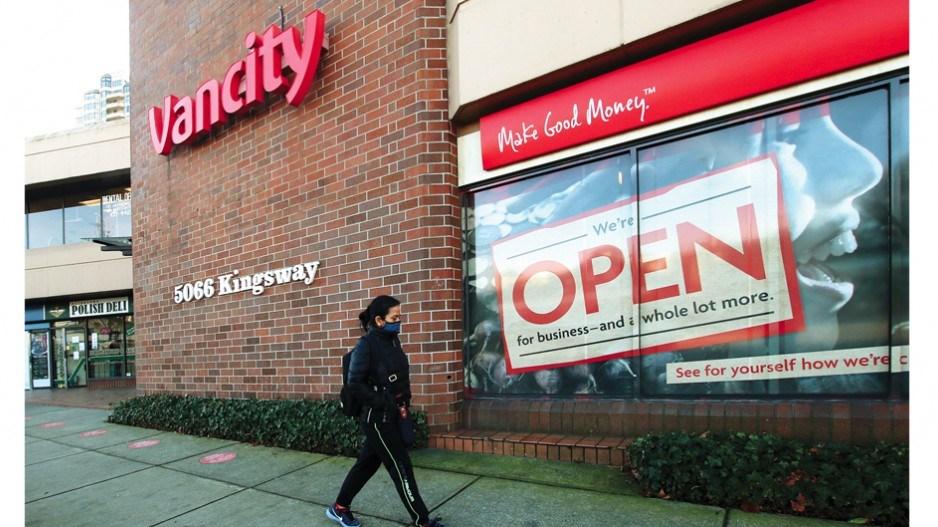Two U.S. bank closures in the past week and overnight liquidity concerns at Switzerland's second-largest bank, Credit Suisse, have caused jittery investors worldwide to sell bank stocks and depositors to be wary about their money's safety.
Academics and economists stressed to BIV that they believe the Canadian banking system's comparative corporate consolidation, and wide diversity of deposit sources make it stable.
Despite that, they say that the Canadian Deposit Insurance Corp. (CDIC), should raise the amounts that depositors can be assured that they will get back were a bank failure to materialize.
Central 1 chief economist Bryan Yu, and University of British Columbia Sauder School of Business assistant professor Rajesh Vijayaraghavan, whose specialty is banking, were some of those who said the Canadian banking system is stable.
Vijayaraghavan estimated that the U.S. has 4,708 banks, while in Canada there are far fewer.
Data from Canada's Office of the Superintendent of Financial Institutions data show 81 banks in Canada at the end of 2022. There are 210 credit unions in Canada according to the Canadian Credit Union Association.
The largest Canadian banks, such as the Royal Bank of Canada (TSX:RBC) have a wide diversity of depositors and loan recipients, others might be slightly more skewed toward one sector. Edmonton-based Canada Western Bank, for example, might have a disproportionate weighting of customers in the oil sector, Vijayaraghavan said.
That skewing, however, would not be anywhere near as heavily tilted toward one sector as was the case with Silicon Valley Bank (SVB), which specialized in providing loans to upstart technology companies and ran into trouble with liquidity last week, prompting regulators to close the bank. A second bank, New York's Signature Bank, also closed for similar reasons.
Like in the U.S., were a Canadian bank to close, depositors would have protection up to a set threshold.
Current CDIC rules say that in the case of bank closures, depositors are entitled to get back $100,000 in each of eight classes of account, and at each separate bank.
The eight categories of account include:
• deposits held in a single name;
• deposits held in trust;
• joint deposits held in more than one name;
• registered retirement savings plans (RRSP);
• registered retirement income funds (RRIF);
• tax-free savings accounts (TFSA);
• registered education savings plans (RESP); and
• registered disability savings plans (RDSP).
People with $100,000 in three of those accounts, for example, would be entitled to $300,000. If those people had that money in those three accounts at three separate banks, they would be entitled to $900,000.
Vijayaraghavan said the $100,000 limit should be raised because the CDIC put it in place in 2005, and it has not increased with inflation.
Another reason to increase it is that B.C.'s Credit Union Deposit Insurance Corporation, in contrast, insures 100 per cent of all deposits at B.C.'s credit unions, Yu said. In Ontario, that deposit-insurance cap at credit unions only extends to $250,000 but it is still much higher than the $100,000-per-account threshold at banks, he added.
The Canadian bank-deposit insurance limit is also lower than in the U.S., where the Federal Deposit Insurance Corp. insures customer deposits up to US$250,000. On Sunday, after SVB was closed, the U.S. Federal Reserve assured all depositors that they would "have access to all their money" - a move that caught many by surprise.
Vijayaraghavan said that this dramatic move was not only a precedent for the U.S., but it also may be one for other governments worldwide.
"Probably, given that that's the policy that was adopted in the U.S., I think it's quite likely that it might be followed here as well," he said of full deposit insurance in any potential future bank closure in Canada.
One other wrinkle in the insurance of assets in Canadian banks is that the insurance only relates to assets such as deposits and Guaranteed Investment Certificates (GICs).
The CDIC does not insure stocks in a TD Waterhouse discount brokerage account, for example.
People who hold stocks or exchange-traded funds (ETFs) in their self-directed RRSPs, for example, will still own those assets even if the bank collapses, Vijayaraghavan said.
He called TD Waterhouse "a middle-person who facilitates the trade."
"You get a document, or if you have an online account, it's already registered in their system," he said of owning shares in stocks.
He gave the example of the SVB collapse, and said that when the bank was closed, its systems were still working so people could go into online accounts and see what was in their accounts.
"The main thing for customers to keep in mind is not to panic," he said.
"This is a good time for them to understand how healthy each of their banks are."



